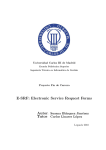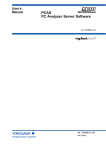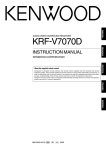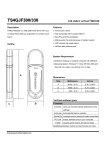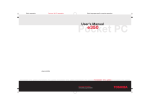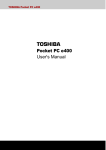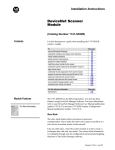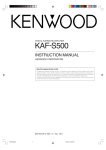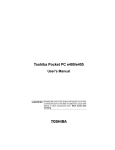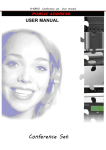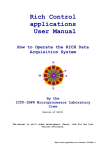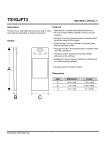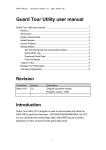Download Fingerprint Software User Manual
Transcript
Fingerprint Software User Manual System Requirements......................................................................................3 The first time to use .........................................................................................4 How to Open the Menu for Fingerprint Software..............................................9 IE AutoLogin ..................................................................................................12 How to "Save ID and Password"............................................................. 13 ID/Password AutoLogin auto-filling .........................................................16 AutoLogin Database Manager ................................................................ 20 My Favorites ..................................................................................................22 User Settings .................................................................................................25 Fingerprint registration ...................................................................................26 Fingerprint Software Password Setting..........................................................28 Fingerprint Life Time Setting ..........................................................................29 FlashMail .......................................................................................................30 E-mail Account Settings ..........................................................................31 Function Settings ....................................................................................35 Read Mail................................................................................................ 37 Sending E-Mail .......................................................................................40 Address Book Summary .........................................................................42 Change Contacts Information .................................................................43 How to add new contacts.................................................................44 How to remove contacts ..................................................................49 DataBackup ...................................................................................................50 Software Introduction ..............................................................................51 Function Setup........................................................................................52 Backup............................................................................................. 54 Restore ............................................................................................ 56 Synchronize.....................................................................................58 Advanced Setting ............................................................................61 Folder Security............................................................................................... 62 File Security ............................................................................................ 66 Right-Click .....................................................................................................69 System Requirements System Requirements Recommended Pentium IV or higher or other compatible machines. Recommended RAM of at least 256 MB or higher. Windows 2000 SP4 / XP SP2 / Vista. The first time to use 1. First time use, when plug in a new Fingerprint Disk, it will automatically start with Fingerprint Enrollment Wizard . 2. If the Fingerprint Disk had been registered , it will automatically run Fingerprint Authentication dialog. Note: If the autorun manner did not start . Please open the Windows Explorer, a“CD device" and a"Removable Disk" as shown, please run 'autoverify.exe' to start. : Add new fingerprints through this wizard. 1. Select a finger you want to register, then click "Next(N)". The selected finger is highlighted. 2. Place your finger on the sensor as shown in the middle of three pictures in the lower left side. 3. Continue removing and placing your finger until the "Back" button turns into "Next", and then click "Next". 4. You can continue to register another fingerprint (up to 10 fingers). We recommend that you register two or more fingers in case your finger gets hurt. Click "Next" button to continue to register another finger. Click "Finish" button to finish the registration. Enter your rescue password and password hint. You can use this password to access content instead of fingerprint verification in case you lose your Fingerprint Disk. Click "OK" is finish. How to Open the Menu for Fingerprint Software If the "Fingerprint Life time setting" is set "Never use Fingerprint enroll", everytime you click the trayicon will open the "Menu for Fingerprint". If the current fingerprint expires, you must re-verify the fingerprint. "Fingerprint Identification" dialog will ask you for your right fingerprint . Verify your fingerprint Click on the Fingerprint Software trayIcon verify your fingerprint. Or press "Password >> " button and enter your password. and slide your finger to If the fingerprint verification succeeds, the Menu for Fingerprint Access will appear. IE AutoLogin IE AutoLogin allows you to automate the entry of ID and/or password on a web site. At first, you save your ID and/or password for a web site. When you go to the web site, IE AutoLogin fills in the dialog boxes automatically after a successful fingerprint or password verification. This application is for Internet Explorer only. How to "Save ID and Password" IE AutoLogin auto-filling AutoLogin Database Manager How to "Save ID and Password" 1. Start Internet Explorer and go to the web site for which you want to store your ID and/or Password. 2. Type your Username and Password. 3. Click the icon on the taskbar of Internet Explorer and choose "Save ID and Password". 4. If the "Fingerprint Life time setting" is set "No need fingerprint verify", the Username and/or Password is saved. If the current fingerprint expires, you must re-verify the fingerprint in order to save the Username and/or Password. "Fingerprint Identification" dialog will ask you for your fingerprint verification.(This process can also be executed by typing in your password.) Verify your fingerprint or password. After the verification succeeds, the Username and/or Password is saved. ID/Password AutoLogin auto-filling Method 1. Start Internet Explorer and go to the web site where you have saved your ID and/or Password. Verify your fingerprint or password when asked. Method 2. You can also go to the web site directly without starting Internet Explorer via the Menu for Fingerprint Access. Click IE AutoLogin and choose the web site you want to go to. Internet Explorer will automatically start and show the web site you have chosen. And your ID and/or Password will automatically be filled in. AutoLogin Database Manager You can delete ID and Password, and manage all the URLs you've already registered. My Favorites You can get access to your "Favorites" included in Internet Explorer. Carry-On My Favorites 1. Open "Menu for Fingerprint Access". (See "How to Open the Menu for Fingerprint Software") 2. Click "My Favorites" and then select "Organize..." 3. My Favorites in Internet Explorer will appear on the left side. 4. You can select a favorite web site you want to add and copy them into "Fingerprint Disk". Also, you can delete a web site listed in the right pane. o Computer Frame : The favorites already registered into Internet Explorer are listed. o Fingerprint Frame : The favorites already stored in your fingerprint disk are listed. o Select All : Select all URL in the frame. o Delete : Delete the URL that you selected. 5. You can directly open "My Favorites" through "Menu for Fingerprint Software" User Settings Open "Menu for Fingerprint Access". (See "How to Open the Menu for Fingerprint Software") Select "User Settings". In "User Settings" dialog , you can set : Fingerprint Registration Fingerprint Software Password Setting Fingerprint Life Time Setting Fingerprint registration 1. Open "User Settings". (See "How to Open the Menu for Fingerprint Software") Select "Fingerprint Registration". 2. In the "Fingerprint Identification" windows, there are two ways to to verify your fingerprint. Method 1. Fingerprint Identification : Verify your previously registered fingerprint. The blue fingers show which fingers have been registered. Method 2. Password : Click the "Password >>" button and enter your password if you want to use it instead of your fingerprint. 3. Finger Registration Wizard will start. And you may register or delete your registered fingers. Green : Already registered finger(s). Blue : Selected finger. PS. This product may authenticate the fingerprint, which is other than what is registered due to the similarity in shape of the fingerprint between them. Fingerprint Software Password Setting 1. Open "User Settings ". (See "How to Open the Menu for Fingerprint Software") Select "Fingerprint Software Password Setting". 2. In the "Hint and Password" dialog, you can set your rescue hint and password. Fingerprint Life Time Setting Life of Current Fingerprint If you are working in an environment which requires full confidentiality, you may set the "Fingerprint Life" to a short period of time (e.g. two minutes). When you leave computer, current fingerprint soon expires. After current fingerprint expires, you must re-verify the "Fingerprint Life". This feature offers you full confidentiality. Open "Menu for Fingerprint Software / UserSettings". (See "How to Open the Menu for Fingerprint Software") Select "Fingerprint Life Time Setting" No need fingerprint verify Enter Fingerprint Life Time Every time you re-verify your fingerprint, the life of Current Fingerprint is renewed. FlashMail Introduction Managing multiple e-mail accounts If you have multiple e-mail accounts, you can manage these accounts in the same browser window simultaneously. You are also able to set each account to only receiving certain mails (spam blocking). Conveniently send and receive mails FlashMail is an application that runs on hardware. You can easily access your e-mail accounts when the hardware plugged in the computer, wherever you go. Hot to use Open "Menu for FlashMail" as follows: E-mail Account Settings FlashMail Function Settings Read Mail Sending E-Mail Address Book Summary Change Contacts Information How to add new contacts How to remove contacts E-mail Account Settings If you would like to set up an account, please click on <Setup(S)> in the tool bar and select <Account Setup(A)>. Now you will enter <Account Manager>, as shown below: When you see the left [Accounts in Outlook Express of this PC:] , the account is shown automatically as above. If you would like to add a new account, go to [Accounts in Outlook Express of this PC:] select the existing Outlook Express e-mail account(s), and click <Import> to add the new account(s). Or you can just click <Add New> to setup the account you need. An account setup window will pop up when you click on the <Add New> or <Import> selections. There are three settings: <General>, <Retrieve> and <Send>. Below is an example of how the form is filled, for your guidance: If you used the <Import> button to import your e-mail account in Outlook Express, please enter the password for that account manually. Also, please make sure that the information in <Mail server> is correct. (If you have anti-virus programs, e.g. Norton Anti-Virus, these softwares may include your e-mail server into its virus scanning paths.) If you do not check <Check this account when checking mailbox> option in <Retrieve>, then this account will not be checked for new mails when you click on <Check> on the main screen. If your mail service provider checks your account name and password whenever a mail is sent, please select the <SMTP server need authenticating> option (usually not required), and please enter your account name and password. When you have finished the above settings and clicked <OK>, then setup is completed. Now you will find your account name inside <Accounts Manager / Current accounts>. If you would like to set up other accounts, simply repeat the above steps. Function Settings When you execute , FlashMail main window will appear. Below we will introduce you all main functions . File(F): The main choices are <Outbox(O)> , <Export Mail (E)> and <Exit(X)>. If you would like to send an e-mail, you may directly choose <Outbox(O)> or click on the icon on your tool bar. This will then take you to the outbox window and you may compose e-mails. If you wolud like to export your e-mail, you just select you want export mails, and choose <Export Mail (E)> options in the <File> menu, and select you want save directory, and type file name. It will saved (*.eml) files. If you would like to exit out of FlashMail, choose <Exit(X)> in the <File(F)> options menu, or click on the close button at the upper right hand corner. Edit(E): The main choices are <Select All(A)>, <Select Inverse(I)>, and <Delete(D) >. When you have selected the items that you would like to remove, you may then click on <Delete> option in the <Edit(E)> menu. Select Inverse(I):For example, if you selected items 1 and 3 then clicked on the <Select Inverse(I) > option, items 1 and 3 will now be unselected while the rest are selected. Setup(S): The main options are <Accont Setup(A)> and <Option(O)> and <Address Book(D)> Click on <Account Setup(A)> to manage and set your mailbox. Click on <Option(O)> to change the password entering FlashMail and settings. Click on <Address Book(D)> to manage and set up your address book. The below links link to the explanations of various options in FlashMail: To receive mail please refer to "Read Mail" option. To send mail please refer to "Sending E-Mail" option. To set up personal e-mail accounts please refer to "E-Mail Account Settings" option. Read Mail --Check Mail Before you download any e-mail, you can click on the <Check Mail> button on the tool bar to check whether you have any new mail. If you feel that it takes too long to check mail, you can click on the <Ignore(I)> button. Then it will skip the mailbox currently being checked. Or you can click <Cancel(C)> to terminate any mail checking functions. Simply click on <Close(X)> to exit this window. When you are done checking mail, you will see a list of mails in the mailbox in the inbox window. (The e-mail now are not downloaded onto the Flash Disk yet, they are still located on the server). Now you can, according to your needs, choose to download or delete mails. Download Mail All the ones selected will immediately be downloaded onto Flash Disk, and on the file list you can see that the names have been changed to "Got" instead of "Not yet". 1. --Retrieve All All the mails will immediately be downloaded onto Flash Disk, and on the file list you can see that the names have been changed to "Got" instead of "Not yet". 2. --Retrieve All the ones selected will immediately be downloaded onto Flash Disk, and on the file list you can see that the names have been changed to "Got" instead of "Not yet". 3. --Transfer You can transfer mails (receive and send) on a specific mail account. Click the right side drop-down menu and select account name. 4. Or, you can double-click the left mouse button and the mail will download and open itself. Note: o After you have checked the mail, a "Not yet" status icon will be shown.(see right) o To distinguish the difference, mails with attachments will have a paperclip icon next to it. (see right) o If the e-mail is already downloaded, then a mail icon will appear. (see right) --Delete Mail When you wish to delete any mail, first select the ones you would like to delete and click on <Delete> on the toolbar. A window will then appear to make sure you want to delete , press OK, then the widow will asking whether to <Delete local mail files only> or <Delete with the mails in mail server> . Please choose one of the options and proceed by clicking <OK> and the mail will be deleted. (shown below) If you choose to <Delete with the mails in mail server> . Then the mail will be permanently deleted. Sending E-Mail 1. If you click on the <New Mail> on the Outbox window, a Mail Editor window will appear. 2. In the <To> line, you can enter the recipient's e-mail address. If there are multiple recipients, separate the addresses with semi-colons(;). Or you can click on the <To> button and find the people from your address book. 3. In the <Subject> line, enter the subject of this e-mail. 4. Write the e-mail, and then click the <Send > button on the toolbar. 5. If you only wish to save this e-mail, simply click on <Save> button on the toolbar. Notes: You can select the mails that you would like to edit from the outbox window. Double-click left mouse button to open or send this e-mail. For you to distinguish the difference, mails containing attachments will have a paperclip by the file name. If you have multiple mail accounts, you can choose from the "from" line to select the account. It does not matter whether the mail was sent or not, all mail saved on the disk will remain in the outbox window. Next time when you feel like sending another e-mail, simply follow the above steps to do so. If you want to delete mail, choose the ones that you want to delete and click on <Delete> from the tool bar. Now, a confirmation dialogue box will appear. If you click <OK>, then the selected items will be deleted. (see below) Address Book Summary FlashMail offers a simple way to store your address book. You can have your very own space to store e-mail addresses, home address, and office locations; also, the fax/home phone numbers, instant messaging addresses, and personal profiles (birthdays, family members, etc.) can be recorded in the book too. You can also store company's and personal website addresses, and directly connect to them from here. Importing address book from another mail software You can export csv format address books from other e-mail software(s) into FlashMail's address book. A good example is to use the "Export Address Book" function in Microsoft Outlook. First, convert the file into csv format and then import it into FlashMail. You may also use Microsoft Exchange or any other programs that support imports/exports of csv files to use your address book file. Change Contacts Information Find the name you want from the <Address Book> list and double click on it. Or select the name(s) and click on <Contents> to change the information. Note: If you want to delete a contact, please select the name of the contact and click on the <Delete> button. Related Topics: How to add new contacts How to remove contacts How to add new contacts To add new contacts to FlashMail FlashMail provides two ways to add e-mail addresses and other related information of your contacts: Directly add new contacts from FlashMail Use csv files generated by other programs and import the address book to FlashMail. 1. Directly add new contacts from FlashMail First, move your mouse cursor to the <Setup(S)> menu on the toolbar, and choose<Address Book(D)>, then the following window will appear: When you see the above window, click on the <New> button, or choose <New(N)> from the <File(F)> menu to add new contacts. After the completion of the above steps this window will appear: Fill in the name of your contact and e-mail address. For example: Click <OK> and a detailed form about your new contact will appear, shown below: You can click <Ok> after filling out the information and the process is complete. You will find the name of the new contact in your address book, shown below: 2. Use csv files generated by other programs and import the address book to FlashMail Choose the <Import(I)> option from the <File(F)> menu, then the dialogue below will appear: Select the CSV file that you would like to import and then the following window will appear after you click on <Open>: Now, please choose the contacts you would like to import, and click on the <Import> button. The contacts you selected will be transferred onto Flash Disk address book (see Fig. 1), click <Ok> and it will successfully import the contacts into the address book (see Fig. 2). Fig. 1 Fig. 2 How to remove contacts Remove contacts from address book Select the contacts that you would like to remove from the address book, then click <Delete>. Follow the steps below: First, select the contacts, and click <Delete> . Or use the <Delete> option from the <File(F)> menu, shown below: After you click <Delete>, a message will pop-up to confirm (shown below). If you choose <Yes> , then this contact will be removed. DataBackup Software Introduction Function Setup o Backup o Restore o Synchronize o Advanced Setting Software Introduction Introduction Having a habit to periodically backup files or data in your computer is very important. With an easy and useful tool like DataBackup, you can backup all your files or data easily and efficiently. In addition, it is always difficult to recognize whether the files are refreshed or not. Therefore, people tend to waste time on backup the files, which have no need to do so. On the other hand, they missed the files, which should have been done so. Or when the files are ruined, it always takes a lot of time to restore, but with DataBackup, they will never be a problem to you. Function Setup When running the program, it will immediately open the main screen. It includes four major functions [File], [View], [Setup]. [File] It includes [Open], [Save] and [Quit]. [Open]: You can use this function to open the [*.FO] log file while in [Restore]or [Synchronize] UI. *** "*.FO" logs all the information about backup, including what have been backup, file names, size, type, modified date and path. With these information, it will help you easily restore or backup files. [Save]: You can backup your files. Choose that you want backup file, and select target directory, it will autosave as [*.FO] log file. [Quit]: You can close the program by clicking it. [View] It includes [Backup][Restore]and [Synchronize]. [Backup]: By clicking it, the screen will switch to the Backup UI, or you can directly click the [Backup] icon. [Restore]: By clicking it, the screen will switch to the Restore UI, or you can directly click the [Restore] icon. [Synchronize]: By clicking it, the screen will switch to the Synchronize UI, or you can directly click the [Synchronize] icon. [Setup] It includes [Backup Setting], [Recovery Setting] and [Synchronize Setting]. [Backup Setting]: Advanced setup for [Backup] and [Skipped file type(s)] to easily and efficiently complete the backup. [Restore setting]: Advanced setup for [Restore setting] to avoid the error when restoring the files. [Synchronize Setting]: Advanced setup for [Skipped file type] to precisely complete synchronization. [About]: About "FDBackup" version. Backup By double clicking the program, it will immediately open the main screen. You can click [Backup] in View or [Backup] icon on the screen to switch to the backup function. The way to operate this software is very simple. "Tree View" on your left, and "Main Screen" on the right. Its structure is similar to Windows Explore. Backup Operation Steps 1. Simply by clicking the files or the data you wish to backup. 2. Clicking [Backup path] to choose or add the path of the backup file. 3. After choosing the path, you can click [backup icon] to start to backup. 4. These file will be saved as "*.FO". You can easily have the information of the files you backup. Any backup will be saved as "*.FO". "*.FO" logs all the information related to backup, including what have been backup, file names, size, type, modified date and path. 5. You can have the information of the number of files, copied files, copying progress, and total progress etc. In addition, you can click [Cancel] to stop the backup or click [View] to see the backup_log information. Others [Refresh]: Refreshing, back to its original screen. [Clear checkbox]: Clear all the marks. Restore By double clicking the program, it will immediately open the main screen. You can click [Restore] in View or [Restore] icon on the screen to switch to the restore function. Restore Operation Steps 1. By clicking [Open] in the File(F) to open "*.FO" if you intend to restore. 2. After checking the files, you may choose the files or the data you would like to restore. 3. Choose the directory you wish to restore with [Original path] or [Other path] If choosing [Original path], it will automatically restore the files or the data to its original path; if choosing [Other path], [Browse for folder] will appear for you to choose the directory you wish to restore. 4. After all the steps have been done, you can start to restore by clicking [restore icon]. 5. You can have the information of the number of files, copied files, copying progress, and total progress etc. In addition, you can click [Cancel] to stop the restore or click [View] to see the restore information. Others [Clear screen]: Clear the data and the screens within the restore function. Synchronize By double clicking the program, it will immediately open the main screen. You can click [Synchronize] in View or Synchronize icon on the screen to switch to the synchronization function Restore Operation Steps 1. When synchronizing, click [Open] in the File(F) to open *.FO, or the icon on the UI .(as shown ) 2. When reading files, source path and target path will be compared and listed the differences. 3. You can decide how to manage source path and target path, by clicking [Synchronize] to synchronize. (as shown ) 4. You can get the information of the number of the files, copied files, copying progress, and total progress etc. In addition, you can click [Cancel] to stop the synchronization. Or you can click [View] to check the synchronization updated information after it is complete. When you use synchronize funcion, you can see the synchronize screen as below: The way to synchronize :No active. If you do not want synchronize the files, you can click active column become no active. : Copy [Source path] to [Target path]. : Copy [Target path] to [Source path]. Others icon shows: [Clear screen]: Clear the data and the screens within the synchronize function. : Display "right to left files" . : Display " left to right files" : No action. Advanced Setting The software provides you with the basic backup, restore and synchronize functions. When you are familiar with these basic functions, you can use the advanced setting for backup, restore, and synchronize to meet your need and requirement more efficiently. The Option Setting for Backup, Restore, and Synchronize is shown as below: [Backup Option Setting] You can set [Backup Option] and [Skipped file type(s)] while doing backup. [Backup Option]: You can choose [Renew all] or [Only backup the new file or the modified file] while doing backup. The default option is [Only backup the new file or the modified file] to save your time on the files which have been backup or never been modified. [Skipped file type(s)]: You can use [Add] or [Remove] to manage the files you do not want to backup. [Restore Option Setting] You can set [Restore Setting] while doing restore. [Restore Option Setting]: When you intend to restore after the files are ruined, you can set [Replace all] or [Skip all] or [Confirm by user] of the original existed files. The default option is [Replace all]. Please be very careful when doing this in case of any accident happens. [Synchronize Setting] You can set [Skipped file type] while synchronizing. [Skipped file type]: You can use [Add] or [Remove] to manage files while synchronizing. Folder Security Folder Encryption Folder Decryption Folder Encryption : Encrypted folders enable fingerprint security to all files within a folder. 1. Point cursor to the folder you wish to encrypt and right-click. Choose "Encrypt Folder" from the menu. 2. When authentication is successful, the folder (and files inside) will be encrypted. Files inside this folder will also have a lock on their icons. 3. Moving files into an encrypted folder will cause those files to be automatically encrypted. When removing files from an encrypted folder to a non-encrypted area, "Fingerprint Authentication" dialog will ask you for your fingerprint, and the file will be decrypted. Folder Decryption: To decrypt encrypted files. Right-click on the encrypted folder, and choose " Decrypt Folder " from the menu. If the "Fingerprint Life time setting" is set "Never use Fingerprint enroll", the folder will be decrypted. If the current fingerprint expires, you must re-verify the fingerprint in order to decrypt the files. "Fingerprint Authentication" dialog will ask you for your fingerprint verification. (This process can also be executed by typing in your password.) When authentication is successful, the folder will be decrypted. The icon of the decrypted folder will return to its normal appearance. Files inside this folder will also be decrypted and the icons will have no locks. File Security File Encryption File Decryption File Encryption Your encrypted files can only be accessed by fingerprint (or password). 3. Point cursor to the file you want to encrypt and right-click. Choose Encrypt File from the menu. 4. When authentication is successful, the file will be encrypted. Encrypted files will have a lock on their icons. File Decryption To decrypt encrypted files. Point cursor to the file you want to decrypt and right-click. Choose Decrypt File from the menu. If the "Fingerprint Life time setting" is set "Never use Fingerprint enroll", the file will be decrypted. If the current fingerprint expires, you must re-verify the fingerprint in order to decrypt the files. "Fingerprint Authentication" dialog will ask you for your fingerprint verification. (This process can also be executed by typing in your password.) When authentication is successful, the file will be decrypted. The icon of the decrypted file will have no lock and will go back to its normal appearance. Right-Click Menu for Fingerprint Click the function, it will popup the fingerprint software menu Format Right-click the icon in the system tray , popup the "Format" function . If click , it will erase all data in this disk . Exit Click "Exit" , it will colse the "Fingerprint Software menu" and the trayicon will disappear, and the "Security Area" will be switch into the "CD-ROM Area" on Explorer window.. Next time to plug If the Fingerprint Disk had been registered , it will automatically run Fingerprint Identification dialog. then slide your finger to verify your fingerprint , if the fingerprint verification succeeds, the Menu for Fingerprint Access will appear.







































































